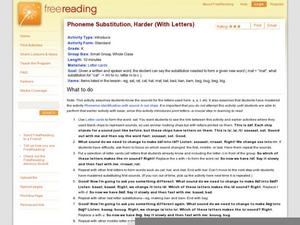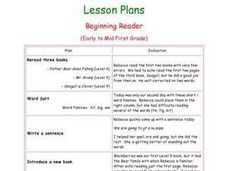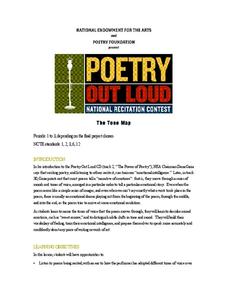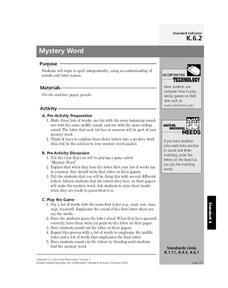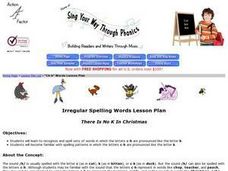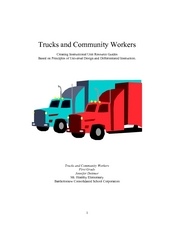Curated OER
Phoneme Identification with Sound-it-Out Chips
Looking for a tangible way to help emerging readers identify phonemes? You've found it! They use chips without letters to segment single-syllable words into first, middle, and last sounds. As you say each sound, scholars place a chip on...
Curated OER
Beginning and Ending Consonants
Young readers explore consonant sounds. In this beginning phonics lesson, learners fill in a beginning/middle/end vertical column chart with the sounds they hear in the pictured object. Practice spelling CVC words.
Curated OER
Introduce Last Sound Segmenting (Mico Version)
What is Mico trying to say? Use a puppet to make this final-phoneme activity more engaging for kindergartners. Using three picture cards at a time (included), they listen to him say a final sound. To which of the three images is he...
Curated OER
Phoneme Substitution, Harder (With Letters)
Emergent readers create new words by changing a phoneme, using sets of letter cards to spell out each CVC word. They begin by substituting initial sounds, then final sounds, and lastly the middle vowel. Help them sound out each word,...
Curated OER
Phoneme Segmenting Accuracy
Take your kindergartners on a journey to the mythical planet Paz where residents segment words into phonemes, touching parts of their arm with each sound. This physical response to phoneme segmenting will appeal to your physical learners...
Curated OER
First Sound Segmenting Accuracy
What's the sound, Mico? Use your class' favorite puppet (in this example, Mico) to teach them about initial sounds in single-syllable words. Using the picture cards provided, choose three and lay them out in front of learners. When Mico...
Curated OER
Introduce Onset-Rime Blending
Mico (or your favorite puppet) helps emergent readers recognize words from segmented phonemes. Explain to learners that he struggles with pronouncing words and needs their help. Model how Mico segments sounds in single-syllable words....
Curated OER
Blending Buddies
Learners put word cards together and use the word parts to create correct words. In this phonics lesson plan, students practice pronouncing consonant blends and vowel sounds, demonstrating an awareness of beginning, middle, and ending...
Ken Baker
Phonemic Alliteration Lesson Plan
Old MacDonald had a ... dragon? A shared reading of this funny take on the classic children's song engages beginning readers as they learn about phonemes and alliteration.
Curated OER
Beginning Reader
First graders work in an individual tutoring atmosphere. First the student reads books with the teacher. The student sorts words found in the books using phonetic similarities. Finally, the student writes sentences summarizing the book.
Curated OER
The Tone Map
Poems are meant to be heard. Hearing a poem being read enriches one’s understanding of the tone and mood of the piece. Introduce your class to the sounds of poetry with a packet that not only details how to use poetry recordings in the...
Curated OER
Double Jeopardy-Homophones
Second graders identify homophones as words that sound alike but have different meanings. They, given a pair of homophones, are to explain the meanings of the words using gestures, role playing, or drawing a picture with their partner.
Indiana University
World Literature: "One Evening in the Rainy Season" Shi Zhecun
Did you know that modern Chinese literature “grew from the psychoanalytical theory of Sigmund Freud”? Designed for a world literature class, seniors are introduced to “One Evening in the Rainy Season,” Shi Zhecun’s stream of...
Curated OER
Mystery Word
Help spellers hear words that have the same beginning letter in them and guess the letter. Each speller has a piece of paper where they are to write down the letter once they have identified it. For instance, the teacher will say, "may,...
Curated OER
Everyone Sang - Moods in Poetry
Start by reading the poem "Everyone Sang" by Siegried Sassoon. The archive also houses an audio clip, so consider playing that instead of reading it aloud. After hearing the poem twice, middle and high schoolers will discuss a list of...
Curated OER
Connotation and Denotation: How Word Choice Affects a Paragraph
Review the terms denotation, connotation, diction, and mood in paragraph writing. After defining the terms, middle schoolers practice writing examples of both connotation and denotation. They complete a connotation and denotation...
Curated OER
Segmenting and Blending Words
Students are introduced to the concept of segmentation and blending of words. As a class, they are shown various words and are asked to determine the amount of letters and sounds in each. To end the lesson, they participate in a...
Curated OER
"There Is No K In Christmas"
Do you hear a k in the word Christmas? It sounds like it, but it's really a ch that creates the same sound! Teach young learners this fun song, "There is No K in Christmas," and show them words that use ch to make the same /k/ sound.
Curated OER
"I am a pirate with a wooden leg": Stomping Iambic Pentameter
What is blank verse? Iambic pentameter? Meter? Use the attached document to review these ideas with your middle schoolers. This plan has learners get up and stomp to iambic pentameter, which is a fun change from just clapping the...
Curated OER
"Gazunheit!"
Students study the /a/ phoneme by determining how the mouth move when it makes the sound by imitating a sneeze. They recite a tongue twister, practice writing the lowercase "a" and listen to a story while identifying the letter sound....
Curated OER
Trucks and Community Workers
First graders identify community helpers and their roles. In this transportation lesson, 1st graders complete a series of lessons integrating technology and literacy. Students decode sounds of short u, c/s/ and g/j/ words and improve...
Curated OER
Reader Rabbit 1
Second graders participate in a reading lesson in order to improve phonics skills. They generate the short vowel sound in CVC pattern words. Students blend beginning consonant, short vowel sound and final consonant into words.
Curated OER
Segmenting and Blending Words
Students listen to words, then segment them into sounds, and hear sounds and blend them into words.



